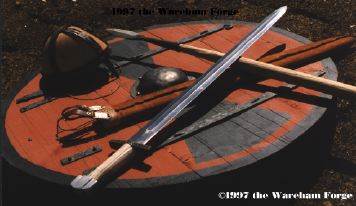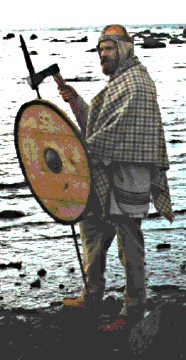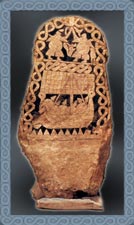

Raiders & TradersBorn of a hostile northern environment, strong, fatalistic, individualistic, searching for riches and expecting little more than to die sword in hand, it's hardly surprising the Vikings were the terror of their age. The first raids in the late 790's had huge impact because of their unsuspected ferocity. The trickle turned to a flood, as word spread through Scandinavia of the wealth to be had. What were once isolated raids became organized plunder, single ships growing to dozens, eventually to number in the hundreds. With massive shows of force, extortion became just as effective as actual battle. And as might be expected, the price rose year by year. Starting in 840 in Ireland and 850 in England, the armies did not return home, but built fortifications and stayed over until spring. In Ireland, it would be the Vikings who would found the first real towns, trading centres such as Dublin, Cork and Limerick. By 870 the Vikings seized York and took control of a huge area of central England. This area eventually had such a large Norse population that it came to be called the Danelaw, because Danish Law took precedence over the local customs. Although the tide of control would flow back and forth between the local kings and the foreign invaders, it would not be until about 1010 in Ireland and 1040 in England that the Viking kings would be expelled. Some historians consider that the Vikings would rule all in the end, considering the Conquest of England by William of Normandy in 1066 to be the last great Viking invasion. Says the Havamal, a collection of folk wisdom from the Viking Age. Although the Vikings who eventually formed the standing armies were for the most part professional warriors, this was certainly not true of the earliest raids. The world of the Norse was a violent one. A man was expected to guaranty his own security, with sword, spear or axe if need be. This created a culture where the basic skills of armed combat with the tools at hand were considered a normal part of a child's education. Although women rarely took part in battles, they too might be required to defend home and children. A wise father would see to it that his daughters could at least defend themselves. The primary weapon was the double edged broadsword. By the beginning of the Viking Age, the sword had assumed the basic shape that it would retain up through the Middle Ages. The blade was wide and long, straight sided with a simple point. It ranged from about 80 to 100 cm long, fitted with a simple bar cross guard and large pommel for balance. Typically a sword weighs only a kilogram or a bit more - the blade's strength comes from the width of the blade, not by its thickness. The finest quality swords were given names, passed down through generations, and might have a reputation greater than the man who held it. 
The Danes, especially, were responsible for reintroducing the axe back into combat, a weapon neglected since before the Romans. With a two kilogram head behind an 15 to 20 cm blade set on a one meter haft, the specially designed 'battle axe' was a true terror weapon. Swung with two hands, such a blade would shatter shields and literally could cut a man from 'crown to navel'. As well as fighting axes, the Vikings were especially fond of light throwing axes - which would do damage even if the back side struck a foe. For most however, the same axe that chopped daily fire wood was pressed into fighting use. Typically, these would be a similar weight to a modern felling axe, perhaps a kilogram and a half on a handle suitable for one or two hand use. The third main weapon of the Viking was the spear. In its common form, it was designed primarily as a thrown weapon for hunting. Set on top of a 1.5 to 1.8 metre long shaft of ash, the slender but thick blade was secured by means of a sturdy conical socket. The specialized hunting spears designed for hunting aggressive game such as boars or bears were also turned to killing the most aggressive opponents of all. These had longer, leaf shaped blades, with narrow 'wings' running off from the base of the blade. Long range combat was carried out with arrows. The 'cloth yard' shaft, as long as a mans arm, was propelled with wooden bows with an oval cross section. Each shaft was tipped with a forged iron head . This could be either a leaf shaped 'broad head' originally intended for hunting, or a special tapered pyramid point designed to pierce shields and armour. For extreme close quarters, a heavy knife with simple slab wood or antler handle was worn at the belt. The Norse favored a distinctive shape with a straight bottom edge and diagonal line to the point called a 'seax'. (It was from this knife that another group, the 'Saxons', got their name.) Size of the seax could vary from small tools with 10 cm of blade to almost sword length versions. To protect themselves, each Viking would carry a large circular wooden shield. About one metre in diameter, it was formed of a set of thin planks bound together by an iron rim. It would be reinforced at the back with several metal strips. One of these ran along the mid line, going across a hole in the center plank to form the handle. The gap was covered on the front side with a dished bowl of metal called a 'shield boss'. Altogether, such a shield would weigh about 4 kg. Standing side by side with just enough room between them to swing their swords, the Vikings would from a 'shield wall', their basic defensive formation. Those with the wealth to afford it would wear a chain mail shirt. Mail is composed of thousands of individual rings, each interlocked to those around it. The result is a flexible 'cloth' of metal which provides good protection against cuts. Mail is very heavy however, a shirt with long sleeves and extending down to mid thigh would easily weigh 15 kg or more. Even worn over a thick padded vest, or gambeson, mail provides poor protection against impact - and arrows easily penetrate it. A clue to its desirability, despite these flaws, can be seen on how Saga tales describe the boasts of chieftains. 'My wealth is such that I can equip all my household guard with mail shirts.' Obviously this was as much a statement of status and economics as much as it was physical power. The average warrior was more likely to wear a vest of thick leather, perhaps reinforced with iron rings or bars. Perhaps not as high status, this more practical armour was almost as good against cuts, and certainly protected the ribs better against impact. 
The most fragile part of the body is the head, and every warrior would try to get some kind of helmet to cover themselves. Most were formed of three strips of metal, two forming the crown and the third going around the temple. The gaps between might be filled with dished out iron plates, or with thick leather stiffened by boiling in wax. The front strip often extended down over the brim to form a simple nasal to offer some protection to the front of the face. More elaborate helmets might have metal plates hanging down to cover the sides of the head or face, or even a curtain of flexible chain mail. In every case however, what is most important is what was NOT attached - and that is horns! There is not one single helmet from the Viking Age that has ever been discovered with horns. As common as this popular image of the Viking warrior with the horned helmet is - there is not a single piece of historic evidence for it. The romantic image of the windswept Hero in the horned helmet is purely the product of the Victorian imagination. By the 900's, raiders had been largely replaced by traders. Norse merchant adventurers would adapt the longship hull to create the sturdy freight hauling vessel called a knar. Wider and deeper, the knar still shared the flexibility and shallow draft of the warships. The sample found at Roskilde in Denmark is thought to be typical, about 15 m in length, with a cargo capacity of around 30 cubic metres. These were primarily sailing ships, with an open hold in the centre and only a short length of deck at bow and stern. In them, they were able travel the length and breadth of the world known to the Europeans - and beyond. There were regular voyages between Norse established trade centres such as Dublin, Viking captured towns such as York, and the major centres of Europe such as Paris. 
By taking the knar hull and scaling it down by about a third, it was possible to produce a vessel still large enough to hold considerable cargo, but now small enough to make overland portages possible. It was in boats like this that the Norse merchants, mainly Swedes, would travel the eastern river systems from the Baltic down to the Black Sea, Constantinople and the riches of the Middle East and beyond. Goods would flow north and south along the rivers, with trade stations springing up along the route. One of these was Novgorod, the site of modern day St Petersburg. The local population called the newcomers the 'Rus' - who would eventually give their name to the region as Russia. In the middle of this web of trade routes sat the newly established trade centres in the Scandinavian home lands such as the Danish town of Hedeby and Birka in Sweden. It was here that the raw materials from the Scandinavia crossed the manufactured goods from Europe and the luxury items from the East. These towns were originally started as seasonal markets, but they quickly attracted a population of craftsmen, drawn by access to materials and plentiful customers. Amber, furs, walrus ivory and iron mixed with wine, glass, and ceramics in exchange for silver, spices and silk - and from all regions, slaves. 
Straight barter is sure to have taken place, but it was silver that was the common medium of exchange for all. Jewelry might be used either whole or cut into fragments, into what is called 'hack silver'. Coins from all regions were of a similar size, and would be judged for purity based on an understanding of the honesty of each maker as known though their marks. It is by tracing these silver coins back to their original point of origin that modern archaeologist have learned much about the extent of trade and have determined many dates. In all cases, the most valuable tool for any trader was small a folding pan scale. All silver would be assessed for relative value, then weighed out to finalize the deal. Two cultural traditions of the Viking Age, trade - and violence, would put their mark on the farthest flung voyage of all. In distant Vinland, the First Contact between the exploring Norse and the resident Aboriginals would start off as a matter of trade. The Sagas tell us that the Skraelings were eager to trade furs for both milk and red cloth. As might be expected, the sharp dealing Norse started reducing their side of the bargains as the supplies ran low. Despite this dishonesty, it would be the Norse who started the violence, when a forbidden iron axe became the item of desire. Thus ended the first meeting between the two long separated branches of the human race. It is hard not to wonder what might have happened if that first meeting had not ended in open hostilities.  Visit the Dark
Ages Recreation Company Visit the Dark
Ages Recreation Company
|